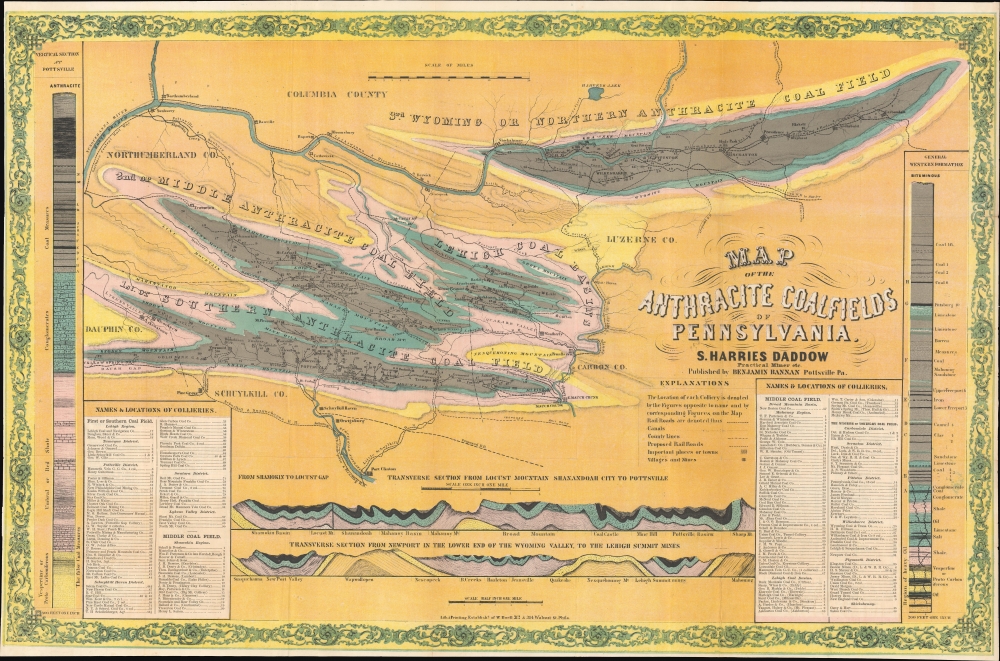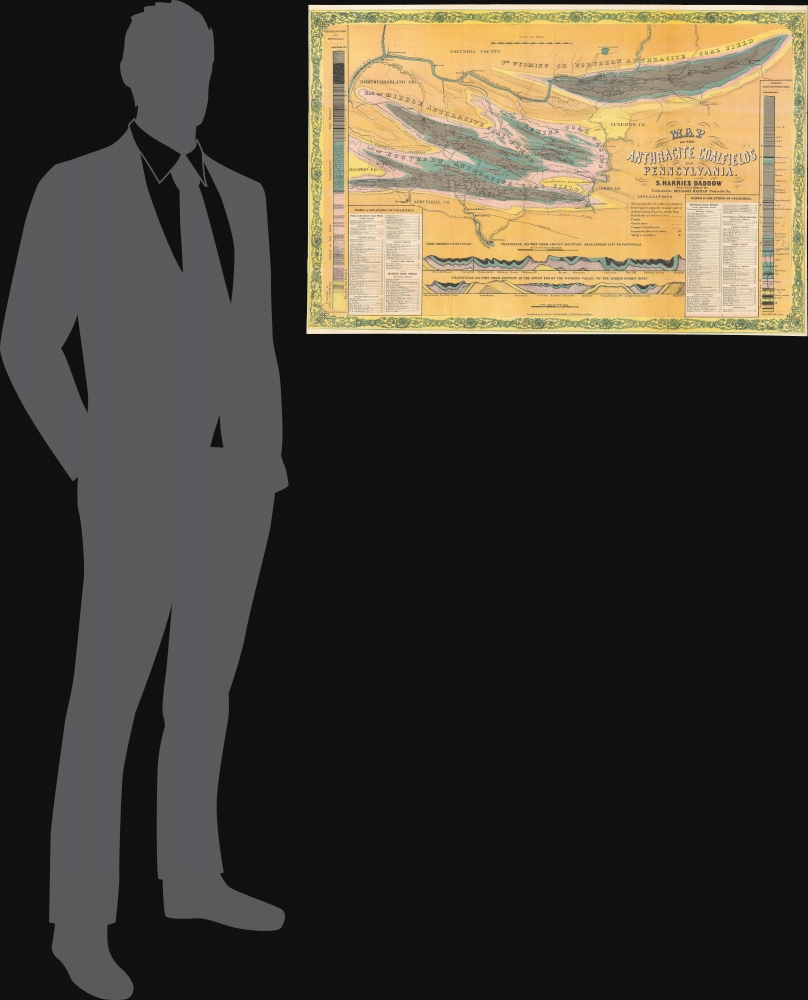This item has been sold, but you can get on the Waitlist to be notified if another example becomes available, or purchase a digital scan.
1866 Daddow Coal and Geological Map of Northeastern Pennsylvania
PennsylvaniaAnthracite-daddow-1866
Title
1866 (undated) 22.5 x 34 in (57.15 x 86.36 cm) 1 : 126720
Description
A Closer Look
In full original hand color, this is loosely centered on Pottsville, the center of Pennsylvania's Anthracite region, and covers parts of Luzerne, Columbia, Carbon, Northumberland, Schuylkill, and Dauphin Counties. It identifies four distinct anthracite zones: the Southern Anthracite Coal Fields, the Middle Anthracite Field, the Leigh Coal Basin, and the Wyoming or Northern Anthracite Coal Field. Specific coal mines are numbers and keyed to a table in the lower left. To the left and right of the map are fascinating vertical sections illustrating the ground composition and various depths, as well as the locations of anthracite (left) and bituminous (right) coal deposits. Other transverse sections illustrate the rippling terrain around Pottsville and the Wyoming Valley. The map further notes towns, large and small, and multiple important railroad lines connecting the mines to Philadelphia and New York.Pennsylvania Anthracite Coal Boom
The Pennsylvania anthracite coal boom in the 19th century marked a transformative period in the state's economic, social, and environmental history. Anthracite, a hard coal known for its high energy content and low impurities, became highly sought after as a fuel source during the Industrial Revolution. This coal, found primarily in northeastern Pennsylvania, was uniquely suited for industrial processes and home heating, as it did not produce the heavy smoke common to other coal types. As demand skyrocketed, towns sprang up around mines, drawing thousands in search of employment. The industry catalyzed the construction of extensive rail networks, facilitating the transport of coal to major cities and ports. However, with the boom came significant challenges: mining led to environmental degradation, miners worked in dangerous conditions for meager wages, and tensions between labor and management frequently erupted in strikes and violence. Despite its challenges, the anthracite coal boom was a linchpin in America's industrial ascent.Publication History and Census
This map was compiled by the mining engineer Samuel Harries Daddow and published by Benjamin Bannan in Pottsville, Pennsylvania. It was printed in Philadelphia by W. Boell. The map was intended to illustrate Daddow and Bannan's 1866 Coal, Iron, and Oil or, The Practical American Miner. At the time, pricing in at $7.50, it was considered one of the most lavish and expensive single-volume works published in the United States, a reflection of the wealth and prosperity that grew out of the Pennsylvania Anthracite Boom. We see six separate examples of the map in OCLC, as well as a holding at the Boston Public Library.CartographerS
Samuel Harries Daddow (March 14, 1827 - March 23, 1875) was an English-American mining engineer and author. Born in Cornwall, England, Samuel immigrated to the United States where he became involved with the Pennsylvania Anthracite Boom. Along with journalist Benjamin Bannon (1807 - 1875), he published Coal, Iron, and Oil, or the Practical Miner, at the time the most lavishly expensive single volume work published in the United States. He married Esther Anne Beadle in 1856, with whom he had one child. More by this mapmaker...
Benjamin Bannan (April 22, 1807 - July 29, 1875) was a publisher, journalist, and political economist based in Pottsville, Pennsylvania in the mid-19th century. Bannan was born in Union City, Pennsylvania, into a Pennsylvania farming family. His father died when he was eight years old, forcing him to quit school to run the family farm. Nonetheless, Bannan taught himself to read and, inspired by the local newspaper (Village Record), wanted to become a publisher. At 15, he took a job at the Berks and Schuylkill Journal, where he learned the printing and publishing business. He rose through the ranks to become a partner. In 1829, Bannan moved to Pottsville, Pennsylvania, the epicenter of Pennsylvania's thriving coal mining industry. There, he founded the Miners' Journal, which he published for more than 40 years. Politically, Bannan was a Whig and a Republican, espousing nativist 'free labor' ideologies, believing that social mobility was an inherent aspect of economic expansion. His ideal society had an independent middle class made up of small entrepreneurial businesses - like coal mining industrialists. He was anti-immigration and, in 1857, mentioned the Molly Maguires in Miners' Journal, linking the secretive group to local terrorism. It is among the first known public references to the Molly Maguires. Along with Samuel Harries Daddow (1827 - 1875), he published Coal, Iron, and Oil, one of the most expensive single-volume works published in the United States at the time. He retired around 1873 and spent his retirement gardening. He died two years later. Learn More...




